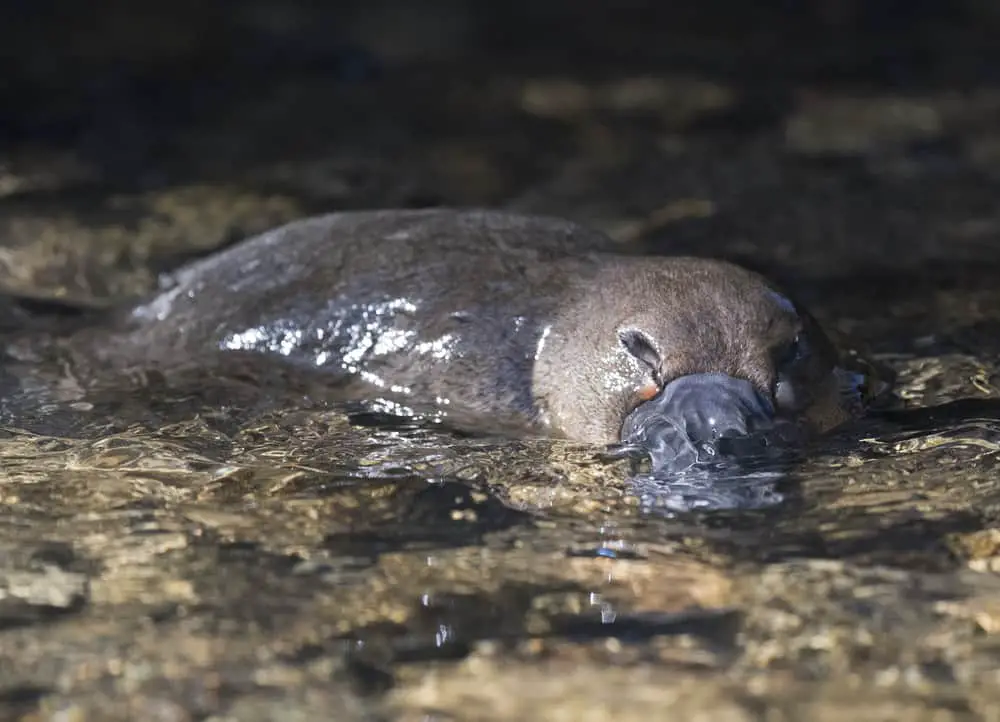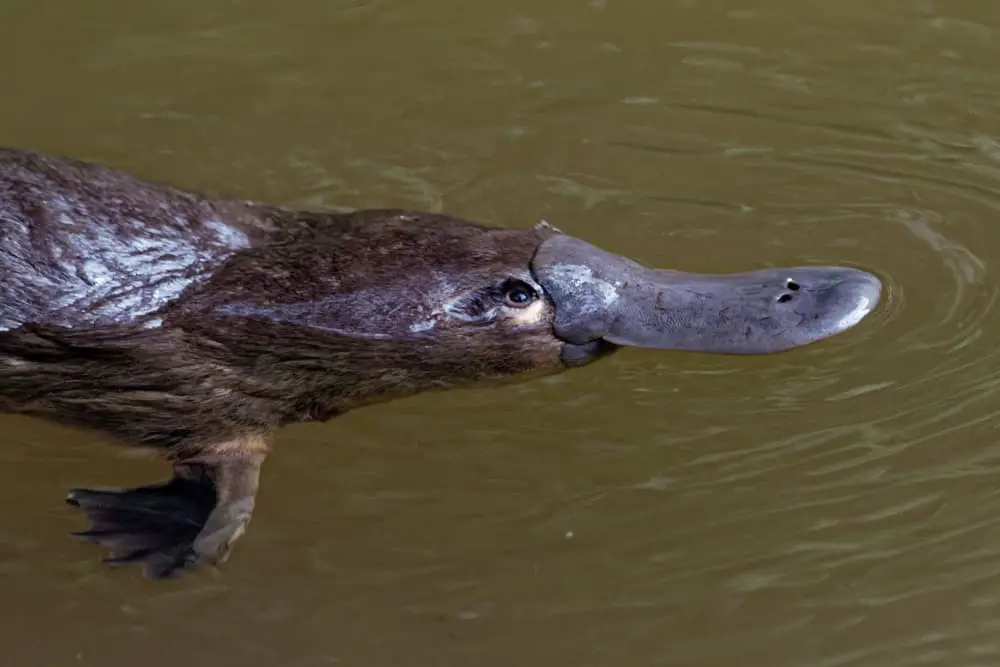The platypus (Ornithorhynchus anatinus) is a monotreme and the sole living species of its family.
It inhabits streams, rivers, and lakes in parts of Eastern Australia, where it feeds on aquatic invertebrates such as insect larvae and shrimp.
The unique features of this mammal make it one of the most distinct species on Earth; for example, its bill resembles that of a duck, yet it possesses fur like other mammals.
In addition to the distinctive physical characteristics, the behavior of the platypus has generated much scientific interest due to its combination of reptilian and mammalian traits.
This article will explore these topics by examining the anatomy, physiology and behavior of the duck-billed platypus.
Scientific Classification
| Kingdom | Animalia |
|---|---|
| Phylum | Chordata |
| Class | Mammalia |
| Order | Monotremata |
| Family | Ornithorhynchidae |
| Genus | Ornithorhynchus |
| Species | Ornithorhynchus anatinus |

Anatomy And Physiology
The duck-billed platypus is a unique creature with an extraordinary combination of characteristics. It has webbed feet, fur, and a bill similar to that of a duck, yet it lays eggs like reptiles instead of hatching them from a shell.
Furthermore, the animal engages in distinct mating rituals and is able to thermoregulate its body temperature through biochemical processes. This aquatic monotreme mammal is native to eastern Australia but can also be found in Tasmania as well as some parts of Southern New Guinea.
The species normally resides in rivers or streams which have been known to span for miles on end. Its diet consists mainly of crustaceans such as shrimp and insect larvae though some members are known to consume small fish and frogs too.
Mating season typically falls within the months of June to October when males compete vigorously for female attention by wrestling each other using their sharp claws located on their hind legs. To cope with extreme temperatures while swimming underwater, they produce antifreeze proteins within their blood stream allowing them maintain thermal homeostasis despite frigid waters.
All these features together make the platypus one of nature’s most mysterious creatures.
The Platypus and Its Predators: Unmasking the Threats
Reproduction And Life Cycle
The reproduction and life cycle of the Duck-billed Platypus is quite unique. Most species of mammals lay eggs, but only two types do so: monotremes and marsupials. The Duck-Billed Platypus belongs to the former group; a primitive type of mammal that uses egg-laying as their primary form of reproduction.
Courtship rituals between male and female platypuses involve visual cues such as neck arching and saliva exchange, followed by physical contact during which mating typically occurs. This behavior usually takes place in water environments, where females construct shallow burrows for raising their young.
After about 10 days gestation period, a single leathery egg is laid inside the burrow before hatching into an immature version of adult platypuses after another ten days or so. The birth development of these animals is incredibly fast; within 3 weeks they can swim and feed on all sorts of invertebrates like worms and insects in order to survive independently from their parents.
Through this rapid growth process, duck billed platypuses reach sexual maturity at 2 years old approximately:
- Females build nests with grass plants to protect their offspring while males take care of them until they are able to hunt alone
- In comparison to other mammals, baby platypuses mature much faster due to its high metabolic rate
- Their fur develops over time through moulting processes, changing coloration as they age
Overall, the reproductive cycle of duck billed platypuses has been studied extensively over time providing us with valuable information regarding their biology. As one of the few living examples left from ancient times, understanding how these mysterious creatures reproduce will be essential for conserving them properly in our modern world.
Diet And Feeding Habits
The duck-billed platypus is an enigmatic creature with a unique diet and feeding habits. It forages for food underwater in the form of aquatic invertebrates, using its sensitive bill to detect prey. Its eyes are closed during these activities, relying instead on tactile communication cues from its beak to guide it through murky waters.
Additionally, this species utilizes a variety of complex foraging strategies including digging into sandbanks or along riverbeds and sieving mud to uncover small crustaceans as well as insect larvae. This omnivorous mammal also consumes terrestrial insects, worms, and other small animals found near water sources such as streams and lakes.
Platypuses have been observed eating both live and dead prey items that they can locate by detecting vibrations in their environment. This combination of searching techniques allows them to find sufficient amounts of food throughout the day – typically up to 20% of their body weight!
Platypuses play an important role in freshwater ecosystems where they naturally occur due to their affinity for consuming small aquatic invertebrates which helps regulate population levels. They are capable predators even if they lack sharp teeth like most mammals; instead relying on strong muscles located within their jawbones to crush hard shells before swallowing them whole.
By understanding the dietary preferences of this unusual species we can better appreciate how they fit into our local habitats.

Habitat And Distribution
The duck-billed platypus is highly adapted to its freshwater habitat, which includes rivers and streams. Its distribution in the wild extends across much of eastern Australia, including Tasmania. It typically inhabits areas with slow or still water that provide ample vegetation cover for nesting sites.
The diet of the duck-billed platypus consists primarily of aquatic invertebrates such as insect larvae and shrimp, although it will also feed on small fish when available. To locate food items, the animal uses electroreception, a sense that allows it to detect electrical signals produced by living organisms in its environment. The platypus feeds mainly at night but has been observed foraging during daylight hours when water levels are low enough for them to access shallow mudflats and banksides where prey may be found.
In terms of conservation efforts, the main threats facing the species’ survival include human activities like pollution, alteration and degradation of their habitats, increasing competition from introduced species, hunting and other disturbances associated with tourism.
As an example of current conservation initiatives aimed at preserving this unique species, many national parks have been established throughout Australia near known populations providing protection against some of these threats while allowing researchers access to study their behaviors and ecology further.
Behavior And Adaptations
The behavior and adaptations of the duck-billed platypus are unique among its fellow mammals. Its social interaction patterns vary greatly from other species, including communication methods that are quite different from those seen in most animals.
The platypus is a solitary creature, spending much of its time alone foraging in the water or on land for food. It also has an unusually short mating season compared to other mammals.
Though they typically keep to themselves, when two platypuses encounter one another their interactions can be quite vigorous. Platypuses often make loud vocalizations during these encounters which scientists believe could be used as a form of territorial defense or even aggression towards potential mates or rivals. They have also been known to dive underwater and engage in physical fighting that sometimes results in injury or death.
Communication between members of this species is largely facilitated through various forms of scent marking with some evidence suggesting audible calls may also play a role at times. For example, adult females will release pheromones into the water while males use saliva secretions to mark territory boundaries on rocks and vegetation near bodies of water. These behaviors appear to help them establish dominance over particular areas of their habitat where access to resources such as food and shelter is optimal.
Conclusion
The duck-billed platypus is an incredible creature. It has unique anatomy and physiology, a complex reproduction cycle, specialized feeding habits, and a vast habitat that spans many countries. Its adaptations have enabled it to survive in its environment for thousands of years.
Despite the extraordinary nature of this species, some may be skeptical about its existence due to its unusual features. However, when observing their behavior in the wild, one can easily note how they use their senses like sight, smell and touch to identify food sources or predators. In addition, they also use electroreception to detect prey hiding underground with remarkable accuracy.
The duck-billed platypus is truly a marvel of evolution that deserves greater recognition through conservation efforts.

